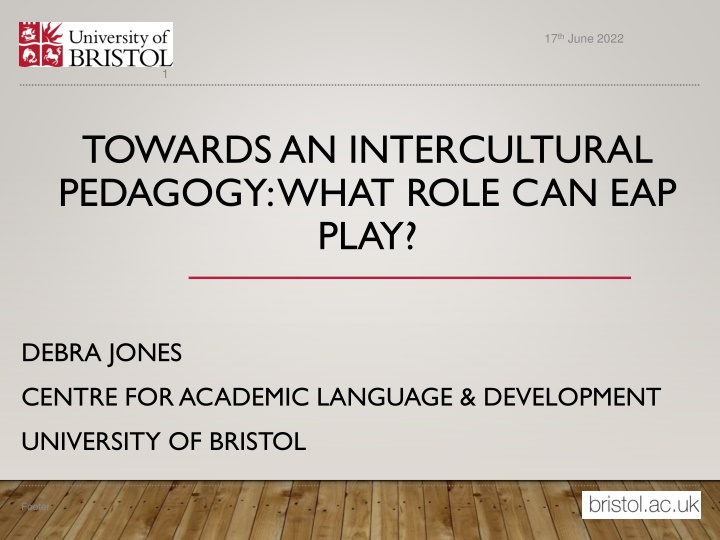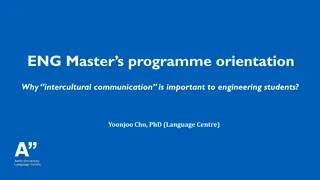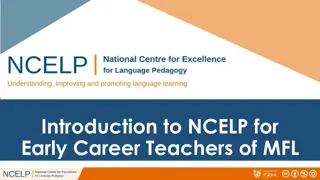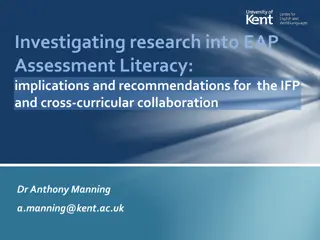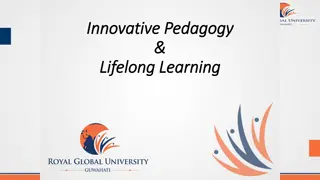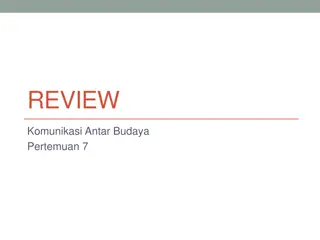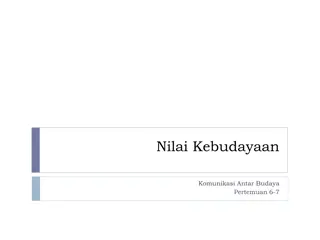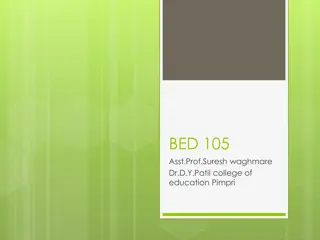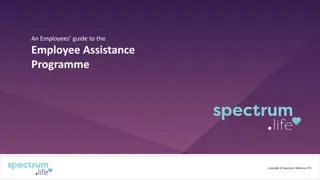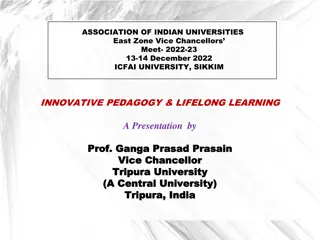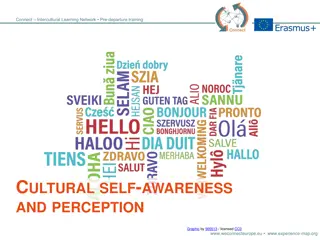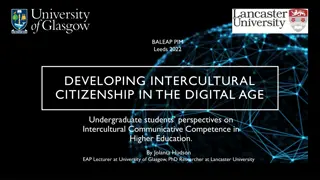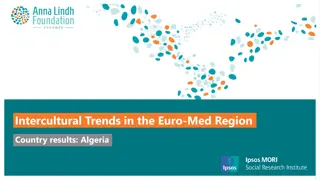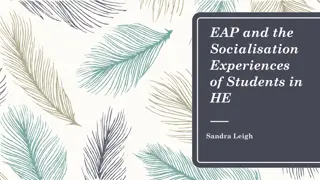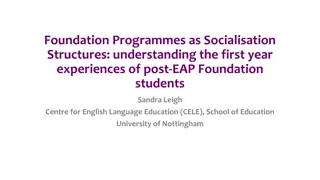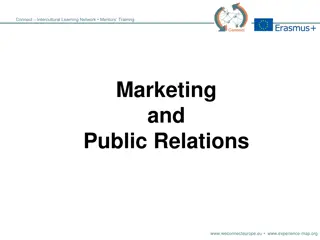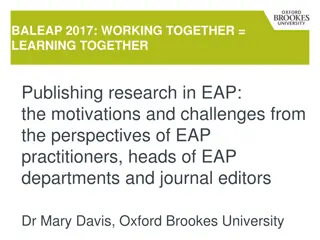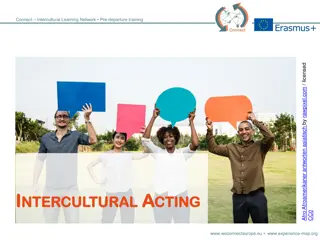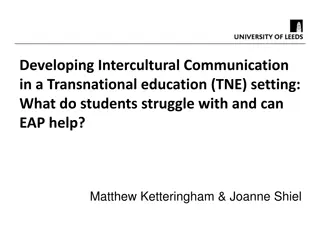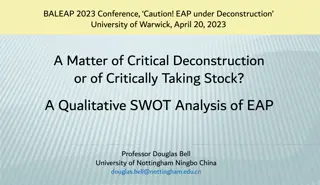Towards an Intercultural Pedagogy: What Role Can EAP Play?
In this insightful piece, Debra Jones explores the potential of English for Academic Purposes (EAP) in fostering intercultural pedagogy. Delve into the discussion on the impact EAP can have on cultural understanding and development in academic settings.
Download Presentation

Please find below an Image/Link to download the presentation.
The content on the website is provided AS IS for your information and personal use only. It may not be sold, licensed, or shared on other websites without obtaining consent from the author.If you encounter any issues during the download, it is possible that the publisher has removed the file from their server.
You are allowed to download the files provided on this website for personal or commercial use, subject to the condition that they are used lawfully. All files are the property of their respective owners.
The content on the website is provided AS IS for your information and personal use only. It may not be sold, licensed, or shared on other websites without obtaining consent from the author.
E N D
Presentation Transcript
17th June 2022 1 TOWARDS AN INTERCULTURAL PEDAGOGY: WHAT ROLE CAN EAP PLAY? DEBRA JONES CENTRE FOR ACADEMIC LANGUAGE & DEVELOPMENT UNIVERSITY OF BRISTOL Footer
PROFESSIONAL BACKGROUND Taught EAP in Japan, China and UK In-sessional Academic Skills/Literacy at Bath Pre-sessional coordinator at Bristol the pre-sessional programme In-sessional coordinator
RESEARCH INTERESTS The impact of internationalisation on learning and teaching in UK HE (not specifically EAP) How has learning & teaching adapted to more internationally diverse cohorts? (if at all?) Curriculum (MATESOL at Bath) Pedagogy (Presessional) In-sessional academic literacy Pre-sessional ways of learning
PRE-SESSIONALS Prepare students to receive the education we provide in the way we provide it Turn them into the kind of students we know how to teach Deficit narrative Focus on what they don t know and can t do Little acknowledgement of prior learning Leads to assimilation model
ONE-WAY INTERNATIONALISATION one-way learning where the student is expected to conform to Western notions of scholarship and learning. Ryan, J. (2012). Internationalisation of doctoral education: Possibilities for new knowledge and understandings. Australian Universities Review, 54(1), pp. 55 62.
WHATS THE PROBLEM? Unsustainable Missed opportunity to realise benefits of interaction between different educational traditions Social justice
IMPACT ON STUDENTS people who give these presentations need to come down to earth [referring to tutors giving a lecture], and if they generalise, they need to do the kind of generalisation which doesn t insult the other culture or which doesn t look down on other cultures (Student 8). Hayes, A. (2019). We loved it because we felt we existed in the classroom! : International students as epistemic equals versus double country oppression.
IMPACT ON STUDENTS I was very successful in university study and at work in China. I thought of myself as a very competent person. However, I first tasted the bitterness of failure and disappointment in here. The pain seemed to have gone straight into my bones. I don t think if I have ever cried in China. But I don t know how many times I have cried here (Chinese student I) Gu & Schweisfurth, (2006). Who Adapts? Beyond Cultural Models of the Chinese Learner.
THE CHALLENGE It s all very well to do things to attract students in, but it s what you do when they are here that s important, and that we don t do . . . we don t claim to understand it (Robson & Turner, 2007)
A MORE DIALOGIC APPROACH? Could/should we change our assumptions about learning? Could/should we build on students prior learning experience? Could/should we change our pedagogy? Could/should we be more flexible and open to new ways of teaching and learning?
INTERCULTURAL PEDAGOGY intercultural / cross-cultural learning / intercultural dialogue commitment to core values such as diversity, tolerance and equality open and respectful exchange of views Castro, P., Lundgren, U. & Woodin, J. (2020) Intercultural dialogue: An educational approach to higher education internationalisation. = learning about
A TRANSCULTURAL APPROACH mutually beneficial dialogue (Song & Cadman, 2012) a reciprocal exchange of knowledge and world views to generate new ways of knowing (Singh, 2009; Ryan & Viete, 2009) a new, shared culture emerging from the interaction of two cultures (Cadman & Song, 2012) new academic ethos (Ryan, 2012) = learning from and being changed by
TRANSCULTURALISM extends the idea of intercultural by implying change as a result of interaction Transculturalism is the process of reaching beyond interculturalism in education, to create a shared culture that is different from the original cultures of both teachers and students (see Cadman 2000) Song, X. & Cadman, K., 2012. Education with(out) distinction: Beyond graduate attributes for Chinese international students
RESEARCH QUESTION We should be asking ourselves if we have nurtured a pedagogical environment that is conducive to East Asian students being able to demonstrate their abilities. Moosavi, (2021). The myth of academic tolerance: the stigmatisation of East Asian students in Western HE
RESEARCH QUESTION What would this look like? How can we achieve it? My argument: Involvement of students as partners Teachers to take a critical and reflexive approach to their assumptions about teaching and learning
CURRENT RESEARCH ON PEDAGOGY Mapping the research on pedagogies with international students in the UK: a systematic literature review Lomer & Mittelmeier (2021) Reviewed 49 journal articles from 2013 to 2019 which presented empirical evidence on pedagogic practices relating to international students in the UK Findings: literature reflected disparate, wide-ranging practice making it impossible to synthesise and draw conclusions international students continue to be framed as in deficit or passive, rarely as partners or knowledge agents. = Need to shift perceptions
PERCEPTIONS OF LECTURERS Previous research: Awareness of need for change Unsure how to go about it Lack of time / lack of institutional support Problematisation of international students Perception that language is the primary problem
FROM MY RESEARCH Teaching methods are still fairly traditional but creativity often prevented by practicalities, e.g. rooms, higher student numbers. Language and students ways of learning are still problematised, e.g issue of questioning. Some awareness of diversity within national groups and the need to change and adapt but to solve problems rather than as a benefit Awareness of the need to know more about learners, but little actual knowledge of students educational background.
ROLE OF LECTURERS There is a perception that language and academic skills support is insufficient and academics are increasingly expected to adapt their pedagogy to provide support" (Savvides, 2020) A head of school challenged the assumption that proficiency in the language of instruction could be equated with intellectual capacity: Not everything is a language problem: teaching is a co-learning experience (Robson & Turner, 2007)
ROLE OF EAP Bridging the gap Rather than bridging the gap, could we meet on the bridge? Ryan, J. & Viete, R., 2009. Respectful interactions: learning with international students in the English- speaking academy.
WHAT ROLE CAN EAP PLAY? Challenge our own assumptions about teaching and learning e.g. being active, asking questions, silence Finding out more about teaching styles they are used to and how they feel about them? Negotiate with students - ask students how they feel about our teaching style? Could we do things differently? Justify our pedagogy not "We're doing this because that's what we do here Encourage students to share content from their own language and context
THE STUDENT VOICE We need to not only listen to others (i.e. International students) but think about how we talk to them so that 'then you begin to investigate what it is that silences me rather than take this very deterministic position - since my skin colour is this, my sex is that, I cannot speak (Spivak, p.62, cited in Joseph, 2008, p.37)
FURTHER READING https://internationalpedagogies.home.blog/critical-reading-list-for- researchers/
02 March 2025 REFERENCES Cadman, K. & Song, X., (2012). Embracing transcultural pedagogy: An epistemological perspective. In: X. Song & K. Cadman, eds. Bridging transcultural divides: Asian languages and cultures in global higher education Adelaide: University of Adelaide Press, pp. 3 21. Castro, P., Lundgren, U. & Woodin, J. (2020) Intercultural dialogue: An educational approach to higher education internationalisation. In U. Lundgren, P. Castro and J. Woodin, Educational Approaches to Internationalisation through Intercultural Dialogue: Reflections on Theory and Practice, pp.3-14. London: Routledge. Hayes, A. (2019). We loved it because we felt we existed in the classroom! : International students as epistemic equals versus double country oppression. Journal of Studies in International Education, 23(5) 554 571, DOI: 10.1177/1028315319826304 Gu, Q. & Schweisfurth, M., (2006) Who Adapts? Beyond Cultural Models of the Chinese Learner, Language, Culture and Curriculum, 19:1, 74-89, DOI:10.1080/07908310608668755 Joseph, C. (2008) Difference, subjectivities and power: (de)colonizing practices in internationalizing the curriculum, Intercultural Education, 19:1, 29-39, DOI:10.1080/14675980701852350 Lomer, S. & Mittelmeier, J. (2021) Mapping the research on pedagogies with international students in the UK: a systematic literature review, Teaching in Higher Education, DOI: 10.1080/13562517.2021.1872532
02 March 2025 Moosavi, L. (2021). The myth of academic tolerance: the stigmatisation of East Asian students in Western higher education, Asian Ethnicity, DOI: 10.1080/14631369.2021.1882289 Robson, S. & Turner, Y. (2007) Teaching is a co-learning experience :academics reflecting on learning and teaching in an internationalized faculty, Teaching in Higher Education, 12:1, 41-54, DOI: 10.1080/13562510601102115 Ryan, J., 2012. Internationalisation of doctoral education: Possibilities for new knowledge and understandings. Australian Universities Review, 54(1), pp. 55 62. Ryan, J. & Viete, R., 2009. Respectful interactions: learning with international students in the English-speaking academy. Teaching in Higher Education, 14(3), pp. 303 314. Savvides, N. (2020). Internationalising the curriculum: Education lecturers understandings and perceptions at a UK university. In U. Lundgren, P. Castro and J. Woodin, Educational Approaches to Internationalisation through Intercultural Dialogue: Reflections on Theory and Practice, pp.3-14. London: Routledge. Singh, M., 2009. Using Chinese knowledge in internationalising research education: Jacques Ranciere, an ignorant supervisor and doctoral students from China. Globalisation, Societies and Education 7, pp. 185 201. Song, X. & Cadman, K., 2012. Education with(out) distinction: Beyond graduate attributes for Chinese international students. In: X. Song and K. Cadman, eds. Bridging transcultural divides: Asian languages and cultures in global higher education. Adelaide: University of Adelaide Press, pp. 269 283. .
Any Questions or comments? debra.jones@bristol.ac.uk
